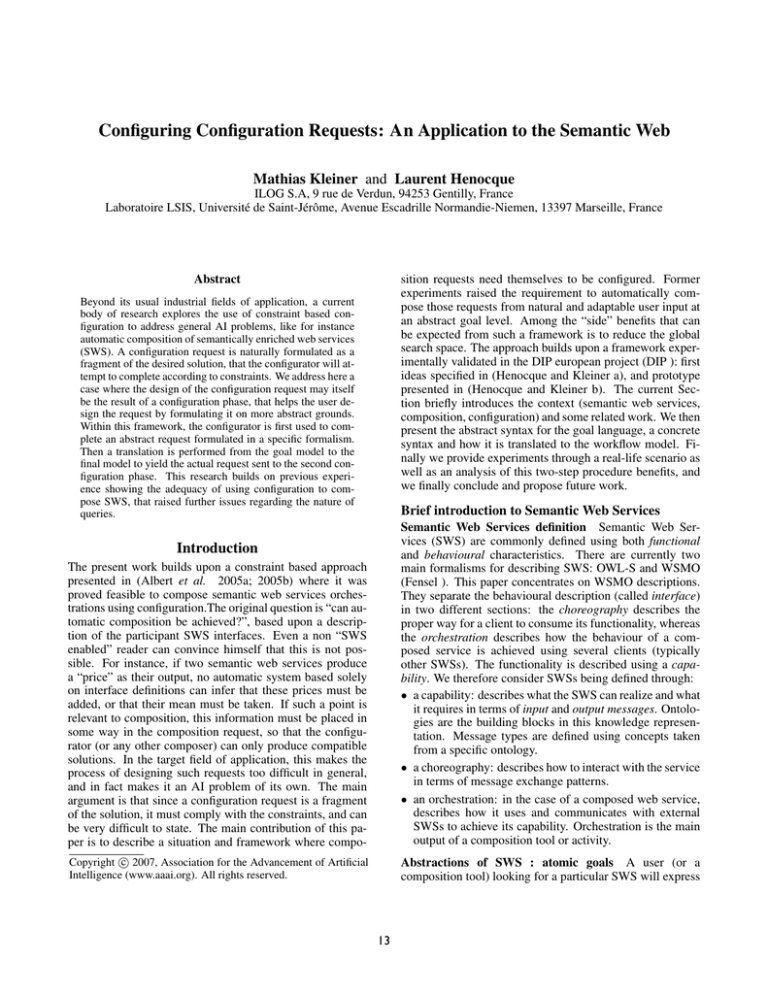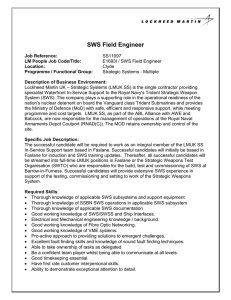
Configuring Configuration Requests: An Application to the Semantic Web
Mathias Kleiner and Laurent Henocque
ILOG S.A, 9 rue de Verdun, 94253 Gentilly, France
Laboratoire LSIS, Université de Saint-Jérôme, Avenue Escadrille Normandie-Niemen, 13397 Marseille, France
Abstract
sition requests need themselves to be configured. Former
experiments raised the requirement to automatically compose those requests from natural and adaptable user input at
an abstract goal level. Among the “side” benefits that can
be expected from such a framework is to reduce the global
search space. The approach builds upon a framework experimentally validated in the DIP european project (DIP ): first
ideas specified in (Henocque and Kleiner a), and prototype
presented in (Henocque and Kleiner b). The current Section briefly introduces the context (semantic web services,
composition, configuration) and some related work. We then
present the abstract syntax for the goal language, a concrete
syntax and how it is translated to the workflow model. Finally we provide experiments through a real-life scenario as
well as an analysis of this two-step procedure benefits, and
we finally conclude and propose future work.
Beyond its usual industrial fields of application, a current
body of research explores the use of constraint based configuration to address general AI problems, like for instance
automatic composition of semantically enriched web services
(SWS). A configuration request is naturally formulated as a
fragment of the desired solution, that the configurator will attempt to complete according to constraints. We address here a
case where the design of the configuration request may itself
be the result of a configuration phase, that helps the user design the request by formulating it on more abstract grounds.
Within this framework, the configurator is first used to complete an abstract request formulated in a specific formalism.
Then a translation is performed from the goal model to the
final model to yield the actual request sent to the second configuration phase. This research builds on previous experience showing the adequacy of using configuration to compose SWS, that raised further issues regarding the nature of
queries.
Brief introduction to Semantic Web Services
The present work builds upon a constraint based approach
presented in (Albert et al. 2005a; 2005b) where it was
proved feasible to compose semantic web services orchestrations using configuration.The original question is “can automatic composition be achieved?”, based upon a description of the participant SWS interfaces. Even a non “SWS
enabled” reader can convince himself that this is not possible. For instance, if two semantic web services produce
a “price” as their output, no automatic system based solely
on interface definitions can infer that these prices must be
added, or that their mean must be taken. If such a point is
relevant to composition, this information must be placed in
some way in the composition request, so that the configurator (or any other composer) can only produce compatible
solutions. In the target field of application, this makes the
process of designing such requests too difficult in general,
and in fact makes it an AI problem of its own. The main
argument is that since a configuration request is a fragment
of the solution, it must comply with the constraints, and can
be very difficult to state. The main contribution of this paper is to describe a situation and framework where compo-
Semantic Web Services definition Semantic Web Services (SWS) are commonly defined using both functional
and behavioural characteristics. There are currently two
main formalisms for describing SWS: OWL-S and WSMO
(Fensel ). This paper concentrates on WSMO descriptions.
They separate the behavioural description (called interface)
in two different sections: the choreography describes the
proper way for a client to consume its functionality, whereas
the orchestration describes how the behaviour of a composed service is achieved using several clients (typically
other SWSs). The functionality is described using a capability. We therefore consider SWSs being defined through:
• a capability: describes what the SWS can realize and what
it requires in terms of input and output messages. Ontologies are the building blocks in this knowledge representation. Message types are defined using concepts taken
from a specific ontology.
• a choreography: describes how to interact with the service
in terms of message exchange patterns.
• an orchestration: in the case of a composed web service,
describes how it uses and communicates with external
SWSs to achieve its capability. Orchestration is the main
output of a composition tool or activity.
c 2007, Association for the Advancement of Artificial
Copyright Intelligence (www.aaai.org). All rights reserved.
Abstractions of SWS : atomic goals A user (or a
composition tool) looking for a particular SWS will express
Introduction
13
requirements allowing its discovery. Such requirements are
called (atomic) goals. Goals generalize SWS, as they may
match several registered SWSs and can hence be seen as
SWS abstractions. Goals are therefore defined very much
like SWS capabilities, specifying available inputs, expected
outputs and constraints. In what follows, we call input and
output roles the abstraction of input and output messages
mentioned at the goal level.
a concept of roles similar to our own definition. Some approaches involve constraint based composition (Hassine et
al. 2006). In (Sohrabi et al. 2006) situation calculus is used
with preferences. As far as we know, no existing language
offers the expressiveness covered by our composition goals
while staying at the abstract goal level.
Abstract Syntax
It is not possible to fully present here the formal specification of the goal language. We present its abstract syntax in
Figures 1, 2 and 3, in the form of a constrained object model.
We are using a subset of the Z language (Spivey 2001) to
document the diagram restrictions that we have chosen to
enforce. We also give unformal semantics to the constructs
indicating their semantics for the workflow composer.
Brief introduction to Composition
Composition is defined as the “act of combining and coordinating a set of Semantic Web Services”. Under such a
definition, “composition” naturally refers to the process involved in computing an orchestration.
Brief introduction to Configuration
A configuration task consists in building (a simulation of)
a complex product from components picked from a catalog of types. Neither the number nor the actual types of
the required components are known beforehand. Components are subject to relations, and their types are subject
to inheritance. Constraints (also called well-formedness
rules) generically define all the valid products. A configurator expects as input a fragment of a target object structure, and expands it to a solution of the configuration problem, if any, addind all necessary elements during search.
This first-order logic problem is semi-decidable in the general case. A configuration program is well described using a constrained object model in the form of a standard
class diagram, together with well-formedness rules or constraints. Technically solving the associated enumeration
problem can be made using various formalisms or technical approaches: extensions of the CSP paradigm (Mittal
and Falkenhainer 1990; Fleischanderl et al. 1998), knowledge based approaches (Stumptner 1997), terminological
logics (Nebel 1990), logic programming (using forward or
backward chaining, and non standard semantics)(Soininen
et al. 2000), object-oriented approaches (Mailharro 1998;
Stumptner 1997).
Figure 1: Goals, roles and concepts model
Related Work
Automated workflow or SWS composition is a field of intense activity, with applications to at least two wide areas:
Business Process Modeling and (Semantic) Web Services.
Approaches to these problems are experimented using many
formalisms and techniques, among others Situation calculus (Sohrabi et al. 2006), Logic programming (Sirin et al.
2003), Type matching (Constantinescu et al. 2005), colored
Petri nets (Dijkman and Dumas 2004), Linear logic: (Rao
et al. 2004), Problem solving methods (Gómez-Pérez et al.
2004), AI Planning (Pistore et al. 2004), Markov decision
processes (Doshi et al. 2005).
This work takes place within an emerging trend of research
for semantic web composition, involving request languages
(EaGLe (Pistore et al. 2004), its evolution in (Pistore et al.
2005) (where the term “composition goals” also occurs)).
The composition language in (Kumar et al. 2005) introduces
Figure 2: Constraints on Goals and Roles model
14
• Data flow’s sources must be of class OutputRole or InternalRole:
∀ n : Role | #(n.isSourceOf ) > 1 •
n ∈ OutputRole ∨ n ∈ InternalRole
• Data flow’s targets must be of class InputRole or InternalRole:
∀ n : Role | #(n.isTargetOf ) > 1 •
n ∈ InputRole ∨ n ∈ InternalRole
• ExtractionFlow has a single source which concept is composite, and targets are concepts included in the source:
∀ n : ExtractionFlow •
#(n.sources) = 1
∧ sources(n) → concept ∈ CompositeConcept
∧ targets(n) → concept
⊂ sources(n) → concept → contains
Figure 3: Concepts and statements model
• Input and Internal roles are targets of dataflow constraints:
Classes The Z formalization of the classes strictly matches
the UML diagrams.
• Atomic goals: abstractions of SWS’s.
∀ r : InputRole • #(r.isTargetOf ) > 0
∀ r : InternalRole • #(r.isTargetOf ) > 0
• Roles: Inputs and outputs of matching SWS’s. Internal
roles can be used to denote intermediate objects in the
orchestration. Each role has a type defined by a concept
taken from an ontology. A concept can either be atomic
or composite.
• Validity of Statements:
∀ a : Statement • a.rvalue ∈ a.lvalue.subconcepts+
• Value Constraints: the solution workflow respects any
given value constraints.
Concrete Syntax
– Unary Value Constraints: the solution workflow ensures that the specified object will respect given
(ranged) values.
– Relational Value Constraints: the solution workflow
ensures that the specified objects will respect given
statement between them.
We briefly provide in Figure 4 a concrete syntax for the abstract goal language. We will use this notation for the examples in the following sections, for instance in Figure 8.
• Dataflow Constraints: the solution workflow ensures the
existence of a specific dataflow between sources and targets:
– IdentityFlow: roles are semantically equivalent.
– OperationFlow: the dataflow will perform an operation
on sources tokens values to obtain targets.
– MediationFlow: the dataflow between sources and targets needs to use a specific mediator.
– AggregationFlow: the dataflow will aggregate sources
into the composite concept target.
– ExtractionFlow: the dataflow will extract parts of the
composite concept source into the targets.
– DecisionFlow: the dataflow will go from source to different targets depending on the guards statements.
– MergeFlow: the dataflow takes any incoming source
and delivers it to target.
Goal Language Constraints We cannot present here all
the constraints that apply to the model. A few of them will
give the flavor of it:
Figure 4: Graphical representation for composition goals
15
Translating Abstract Goals to Composition
Requests
The language used for defining composition requests is not
identical to the workflow metamodel used for the composition phase. Before the results for request generation can be
used, they hence must undergo a specific translation step.
In order to achieve this, we have extended the workflow
model with a limited number (four) extra abstract classes,
presented in Figure 5 with a fragment of the workflow model
itself. Any abstract goal instance (notably the product of
Figure 6: Example of the MergeFlow translation
Figure 5: Extension of the UML2AD subset object model
goal configuration) can be translated using a straightforward
linear algorithm to a proper composition request. Figure 6
shows the translation of a MergeFlow into the activity diagram model. The top diamond represents a MergeFlowConstraint in the request language, the bottom diamond is a true
activity diagram merge node from the workflow model.
Figure 7: A possible input for the NMPC Bundle scenario
Experiments and analysis
The propagation of UnaryValueConstraints such as the
NetworkDetails’ connectionType is key in reducing search
space in the next step (workflow composition). Indeed, only
SWS offering ADSL connections will need to be discovered,
thus limiting the number of candidate choreographies. At
design time, it is possible to check and/or refine the generated request by adding additional constraints (temporal, nonfunctional properties) before proceeding to the orchestration
search.
We present in Figure 9 how this generated composition
request is further exploited by a second configuration step to
create the final orchestration.
We have conducted experiments on a real-life scenario, joint
developped with a DIP use-case partner (British Telecom).
The scenario has been integrated in a full SWS framework,
from composition (out of a full composition goal request) to
execution in the 3-layer descriptions defined in (Norton et
al. ). We used ILOG’s JConfigurator for implementation. In
this problem, the user wants to design a composed web service which offers to buy a bundle of a network connection,
a modem and a PC. Figure 7 shows a possible request: the
user specifies the message he expects as result of the orchestration as well as the information he can provide. Figure 8
shows a possible composition goal solution. The red diamonds represent ExtractionFlow and AggregationFlow constraints. The orange diamonds are DecisionFlow and MergeFlow constraints.
In this example no goal offers both AMD and Intel processors, which forces the composer to create alternative paths.
Although the user gave little information, the composer is
able to provide a very detailed composition request based
on available elements.
Conclusion
This research illustrates on a working example how constraint based configuration use can be cascaded, to first generate in an abstract request language a request for the problem to solve. Since a configuration request is a fragment of
the desired solution, and since such a fragment must comply with the model constraints, the need for user expertise
16
Figure 8: The computed composition goal for the NMPC Bundle scenario
when formulating configuration requests can be fairly well
accepted in the general case. We presented these early results in the hope that they can foster thoughts about the nature of configuration requests and maybe give hints on the
implementation of configuration tool interfaces.
D. Fensel.
The web services modeling ontology.
http://www.wsmo.org. Technical report.
G. Fleischanderl, G. Friedrich, A. Haselböck, H. Schreiner,
and M. Stumptner. Configuring large-scale systems with
generative constraint satisfaction. IEEE Intelligent Systems
- Special issue on Configuration, 13(7), 1998.
Asunción Gómez-Pérez, Rafael González-Cabero, and
Manuel Lamaa. A framework for design and composition
of semantic web services. In Semantic Web Services, 2004
AAAI Spring Symposium Series, 22nd-24th March 2004.
A. Ben Hassine, S. Matsubara, and T. Ishida. A constraintbased approach to horizontal web service composition. In
5th International Semantic Web Conference, 2006.
Laurent Henocque and Mathias Kleiner. Dip deliverable
4.12: Goal-oriented sws composition module specification,
2005. http://dip.semanticweb.org/deliverables.html. Technical report, DIP Project.
Laurent Henocque and Mathias Kleiner. Dip deliverable 4.22: Goal-oriented sws composition prototype, 2006.
http://dip.semanticweb.org/deliverables.html. Technical
report, DIP Project.
A. Kumar, B. Srivastava, and S. Mittal. Information modeling for end to end composition of semantic web services.
In 4th International Semantic Web Conference, 2005.
D. Mailharro. A classification and constraint based framework for configuration. AI-EDAM : Special issue on Configuration, 12(4):383 – 397, 1998.
S. Mittal and B. Falkenhainer. Dynamic constraint satisfaction problems. In Proceedings of AAAI-90, pages 25–32,
1990.
B. Nebel. Reasoning and revision in hybrid representation
systems. Lecture Notes in Artificial Intelligence, 422, 1990.
References
Patrick Albert, Laurent Henocque, and Mathias Kleiner.
Configuration based workflow composition.
In proceedings of International Conference on Web Services
ICWS’05, Orlando, Florida, USA, 2005.
Patrick Albert, Laurent Henocque, and Mathias Kleiner. A
constrained object model for configuration based workflow
composition. In proceedings of the Third International
Conference on Business Process Management, pages 102–
115, Nancy, France, september 2005.
Ion Constantinescu, Walter Binder, and Boi Faltings. Flexible and efficient matchmaking and ranking in service directories. In IEEE International Conference on Web Services,
pages 5–12, 2005.
R. Dijkman and M. Dumas. Service-oriented design: A
multi-viewpoint approach, ctit technical report series no.
04-09. Technical report, Centre for Telematics and Information Technology, University of Twente, The Netherlands, February 2004.
DIP. Data, information, and process integration with semantic web services http://dip.semanticweb.org. Technical
report, DIP Project.
Prashant Doshi, Richard Goodwin, Rama Akkiraju, and
Kunal Verma. Dynamic workflow composition using
markov decision processes. International Journal of Web
Services Research, 2(1):1–17, Jan-March 2005.
17
Figure 9: The computed orchestration for the presented request
B. Norton, J. Lemcke, C. Pedrinacci, Laurent Henocque,
and Mathias Kleiner. Dip deliverable 3.8: An ontology for web services choreography and orchestration,
2006. http://dip.semanticweb.org/deliverables.html. Technical report, DIP Project.
user preferences. In 5th International Semantic Web Conference, 2006.
T. Soininen, I. Niemelõ, J. Tiihonen, and R. Sulonen. Unified configuration knowledge representation using weight
constraint rules. In ECAI 2000 Configuration Workshop,
2000.
J. M. Spivey. The Z Notation: a reference manual. Prentice
Hall originally, now J.M. Spivey, 2001.
Markus Stumptner. An overview of knowledge-based configuration. AI Communications, 10(2):111–125, June 1997.
Marco Pistore, F. Barbon, Piergiorgio Bertoli, D. Shaparau,
and Paolo Traverso. Planning and monitoring web service
composition. In proceedings of the Workshop on Planning
and Scheduling for Web and Grid Services held in conjunction with ICAPS 2004, Whistler, British Columbia, Canada,
June 3-7 2004.
M. Pistore, P. Roberti, and P. Traverso. Process-level
composition of executable web services: on-the-fly versus
once-for-all composition. In European Semantic Web Conference, 2005.
J. Rao, P. Kungas, and M. Matskin. Logic-based web
service composition: from service description to process
model. In proceedings of the 2004 IEEE International Conference on Web Services, ICWS 2004, San Diego, California, USA, July 6-9 2004.
E. Sirin, J. Hendler, and B. Parsia. Semi automatic composition of web services using semantic descriptions. In
proceedings of the ICEIS-2003 Workshop on Web Services:
Modeling, Architecture and Infrastructure, Angers, France,
April 2003.
S. Sohrabi, N. Prokoshyna, and S. A. McIlraith. Web service composition via generic procedures and customizing
18






